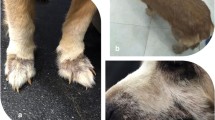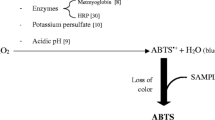Abstract
In the last 20 years, an increasing interest toward oxidative stress has been documented in order to investigate their direct or indirect involvement in several mechanisms regarding oncogenesis and lymphomas in particular. The aim of this paper was to evaluate oxidative stress in dogs affected by malignant lymphoma in comparison to a control group, to investigate what factors can affect this status, and to point out similarities and differences with human. Forty-eight samples from four subjects, affected by high-grade centroblastic polymorphic lymphoma and receiving a standard chemotherapy, have been processed for derivatives of reactive oxygen metabolites (d-ROMs) and biological antioxidant potential (BAP) tests. The obtained data show a condition of oxidative stress in dogs with lymphoma, with a significant increase in reactive oxygen species (ROS) plasma levels and a decrease in antioxidant capacity. No significant differences emerged on the basis of remission. Further results of canine studies about oxidative status in lymphomas could be a model for human, according to analogy between them.
Similar content being viewed by others
References
Alberti A, Bolognini L (2000) The radical cation of N,N-diethyl-paraphenylendiamine: a possibile indicator of oxidative stress in biological samples. Res Chem Intermed 26(3):253–267
Andreadis C, Gimotty PA, Wahl P, Hammond R, Houldsworth J, Schuster SJ, Rebbeck TR (2007) Members of the glutathione and ABC-transporter families are associated with clinical outcome in patients with diffuse large B-cell lymphoma. Blood 109:3409–3416
Asano T, Tsutsuda-Asano A, Fukunaga Y (2009) Indomethacin overcomes doxorubicin resistance by decreasing intracellular content of glutathione and its conjugates with decreasing expression of gamma-glutamylcysteine synthetase via promoter activity in doxrubicin-resistant leukemia cells. Cancer Chemother Pharmacol 74:715–721
Backer LC, Grindem CB, Corbett WT, Cullins JL (2001) Hunter pet dogs as sentinels for environmental contamination. Sci Total Environ 274:161–169
Benzie IF, Strain JJ (1996) The ferric redicing ability of plasma (FRAP) as a measure of “antioxidant power”: the FRAP assay. Anal Biochem 239:70–76
Camkerten I, Sahin T, Borazan G, Gokcen A, Erel O, Das A (2009) Evaluation of blood oxidant/antioxidant balance in dogs with sarcoptic mange. Vet Parasitol 6(161):106–109
Ceriello A (2000) Oxidative stress and glycemic regulation. Metabolism 49:27–29
Fournel Fleury C, Magnol JP, Bricaire P, Marchal T, Chabanne L, Delverdier A, Bryon PA, Felman P (1997) Cytohistological and immunological classification of canine malignant lymphomas: comparison with human non-Hodgkin's lymphomas. J Comp Pathol 117:35–39
Gavazza A, Presciuttini S, Barale R, Lubas G, Gugliucci B (2001) Association between canine malignant lymphoma, living in industrial areas, and use of chemicals by dog owners. J Vet Intern Med 15:190–195
Gavazza A, Sacchini F, Lubas G, Gugliucci B, Valori E (2009) Clinical, laboratory, diagnostic and prognostic aspects of canine lymphoma: a retrospective study. Comp Clin Pathol 18:291–299
Hayes HM, Tarone RE, Cantor KP (1995) On the association between canine malignant lymphoma and opportunity for exposure to 2, 4-dichlorophenoxyacetic acid. Environ Res 70:119–125
Il'yasova D, Mixon G, Wang F, Marcom PK, Marks J, Spasojevich I, Craft N, Arredondo F, DiGiulio R (2009) Markers of oxidative status in a clinical model of oxidative assault: a pilot study in human blood following doxorubicin administration. Biomarkers 14(5):321–325
Karithala P, Soini Y (2007) Reactive oxygen species and antioxidant mechanisms in human tissues and their relation with malignancies. APMIS 115:81–103
Keller ET, MacEwen EG, Rosenthal RC (1993) Evaluation of prognostic factors and sequential combination chemotherapy with doxorubicin for canine lymphoma. J Vet Intern Med 7:289–295
Korkina L, Pastore S (2009) The role of redox regulation in the normal physiology and inflammatory diseases of skin. Front Biosci (Elite Ed) 1:123–141
Kretzschmar M, Pfeiffer L, Schmidt C, Schirrmeister W (1998) Plasma levels of glutathione, alpha-tocopherol and lipid peroxides in polytraumatized patients; evidence for a stimulating effect of TNF alpha on glutathione synthesis. Exp Toxicol Pathol 50:477–483
Mantovani G, Macciò A, Madeddu C, Mura L, Gramignano G, Lusso MR, Mulas C, Mudu MC, Murgia V, Camboni P, Massa E, Ferreli L, Contu P, Rinaldi A, Sanjust E, Atzei D, Elsener B (2002) Quantitative evaluation of oxidative stress, chronic inflammatory indices and leptin in cancer patients: correlation with stage and performance status. Int J Cancer 98(1):84–91
Marconato L, Leo C, Girelli R, Salvi S, Abramo F, Bettini G, Comazzi S, Nardi P, Albanese F, Zini E (2009) Association between waste management and cancer in companion animals. J Vet Intern Med 23:564–569
Marconato L, Gelain ME, Comazzi S (2013) The dog as a possible animal model for human non-Hodgkin lymphoma: a review. Hematol Oncol 31(1):1–9
Mates JM, Segura JA, Alonso FJ, Marques J (2008) Intracellular redox status and oxidative stress: implication for cell proliferations, apoptosis, and carcinogenesis. Arch Toxicol 82:273–299
National Cancer Institute (1982) National Cancer Institute sponsored study of classifications of non-Hodgkin's lymphomas: summary and description of a working formulation for clinical usage. The non-Hodgkin's Lymphoma Pathologic Classification Project. Cancer 49(10):2112–2135
Nelson RW, Couto CG (2008) Lymphoma in the cat and dog. In: Small Animal Internal Medicine, 4th edn, Mosby, St Louis, MO
Pasquini A, Luchetti E, Marchetti V, Cardini G (2008) Analytical performances of d-ROMs test and BAP test in canine plasma. Definition of the normal range in healthy Labrador dogs. Vet Res Commun 32:137–143
Peroja P, Pasinen AK, Haapasaan KM, Jantunen E, Soini Y, Turpeenniemi-Hujanen T, Bloigu R, Lilja L, Kuittinen O, Karithala P (2012) Oxidative stress and redox state-regulating enzymes have prognostic relevance in diffuse large B-cell lymphoma. Exp Hematol Oncol 1:2 doi: 10.1186/2162-3619-1-2 DOI:10.1186 %2 F2162-3619-1-2#pmc_ext
Ray G, Batra S, Shukla NK (2000) Lipid peroxidation, free radical production and antioxidant status in breast cancer. Breast Cancer Res Treat 59:163–170
Tome ME, Johnson DB, Rimsza LM, Roberts RA, Grogan TM, Miler TP, Oberley LW, Briel MM (2005) A redox signature score identifies diffuse large-B-cell lymphoma. Blood 106:3594–3601
Tsai SY, Sun NK, Lu HP, Cheng ML, Chao CC (2007) Involvement of reactive oxygen species in multidrug resistance of a vincristine-selected lymphoblastoma. Cancer Sci 98:1206–1214
Vail DM, Young KM (2007) Canine lymphoma and lymphoid leukemia. In: Withrow SJ, Vail DM (eds) Withrow and MacEwen's small animal clinical oncology, 4th edn. WB Saunders, St Louis
Vajdovich P, Kriska T, Mezes M, Ribiczey Szabo’ P, Balogha N, Ba’nfid A, Arany-To’the A, Gaa’la T, Jakus J (2005) Redox status of dogs with non-Hodgkin lymphomas. An ESR study. Cancer Lett 224:339–346
Valko M, Rhodes CJ, Moncol J, Izakovic M, Mazur M (2006a) Free radicals, metals and antioxidants in oxidative stress-induced cancer. Chem Biol Interact 1(106):1–40
Valko M, Leibfritz D, Moncol J, Cronin MT, Mazur M, Telser J (2006b) Free radicals and antioxidants in normal physiological functions and human disease. Int J Biochem Cell Biol 2(39):44–84
Weijl NI, Hopmann GD, Wipkink-Bakker A (1998) Cisplatin combination chemiotherapy induces a fall in plasma antioxidants of cancer patients. Ann Oncol 9:1331–1337
Winter JL, Barber G, Freeman L, Griessmayr PC, Milbury PE, Blumberg JB (2009) Antioxidant status and biomarkers of oxidative stress in dogs with lymphoma. J Vet Intern Med 23:311–316
Conflicts of interest
The authors declare that they have no conflict of interests.
Author information
Authors and Affiliations
Corresponding author
Rights and permissions
About this article
Cite this article
Pasquini, A., Gavazza, A., Biagi, G. et al. Oxidative stress in lymphoma: similarities and differences between dog and human. Comp Clin Pathol 24, 69–73 (2015). https://doi.org/10.1007/s00580-013-1856-8
Received:
Accepted:
Published:
Issue Date:
DOI: https://doi.org/10.1007/s00580-013-1856-8




